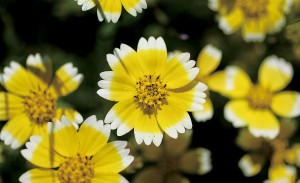The painting actually started in January, as nature’s brushstrokes flickered across Sonoma’s meadows in little flurries. The first harbinger: a magenta-pink dash of shooting-star wildflowers, then a crimson swath of Indian warriors, followed by a white flash of milkmaids.
“Every year, it’s like the return of an old friend,” said Pepperwood Preserve ecologist Michelle Halbur.
As each new color in the native wildflower palette arrives, it recasts the countryside.
 “One of the things I’ve learned is to expect certain splashes of color on the landscape at certain times,” said Jeanne Wirka, who has watched spring gradually blossom on the local canvas for the past 10 years, as the resident biologist at the Bouverie Preserve in Glen Ellen. “One day a field will be all grass and the next day it will be solid purple with lupine.”
“One of the things I’ve learned is to expect certain splashes of color on the landscape at certain times,” said Jeanne Wirka, who has watched spring gradually blossom on the local canvas for the past 10 years, as the resident biologist at the Bouverie Preserve in Glen Ellen. “One day a field will be all grass and the next day it will be solid purple with lupine.”
Even with the record drought of 2013, by now the hills and winding trails are alive with electric-gold California poppies and vivid blue irises. The typical peak wildflower bloom of mid-March, which often coincides with the arrival of spring weather, may fluctuate by a few weeks this year, depending on the overlap of early- and late-blooming species.
Before you lace up your hiking boots and break out the field guide, here’s a stroll through the best wildflower sojourns in Sonoma:
Pepperwood Preserve

Every year, snowy milkmaids and purple hound’s-tongue are the first to light up this 3,120-acre refuge northeast of Santa Rosa.
“It’s like stumbling across your favorite treasure or a prized possession,” Halbur said.
Now, in the peak bloom of March and April, “amid the sea of grasslands there are islands of wildflowers where you find a mosaic of goldfields, creamcups, California buttercups, blue-eyed grass, popcorn flowers, bird’s eye gilia and miniature lupine,” she explained.
Also at Pepperwood, be on the lookout for the scarce Jepson’s leptosiphon, a delicate pink, star-shaped flower that grows along trails near the entrance to the preserve where the guided hikes usually start.
On April 13, the preserve hosts the Pepperwood Wildflower Festival (9 a.m. to 4 p.m.) with free hikes led by local botanists and an hour-long loop of self-guided hikes and interpretative stations.
2130 Pepperwood Preserve Road, Santa Rosa, 707-591-9310, pepperwoodpreserve.org

Bouverie Preserve
“If you know how to read the landscape, then you can start knowing what to expect,” said Bouverie biologist Wirka.
This 535-acre spread of oaks, grasslands and evergreen forests in Glen Ellen comes to life every spring with California buttercups, purplish chocolate-brown mission bells, monkey flowers and Douglas iris.
One of the treats is the endangered Sonoma sunshine wildflower, which blooms only near vernal pools.
“There’s this ‘ah-ha’ moment that people have when they realize, ‘I’ve been looking at these flowers my whole life and never really knew much about them.’ Now they’re learning so much more about their surroundings,” Wirka said.
Half-day Saturday guided hikes are offered March 1 and 15, April 12 and 26, and May 3. Wirka also teaches an in-depth wildflower class on March 29, focusing on specific flower identification in the classroom and the field.
13935 Highway 12, Glen Ellen, 415-868-9244, egret.org
Wildflowers blossom in abundance in most of the regional parks, but veteran docent Phil Dean has come up with two very different wildflower hikes: the most strenuous (and possibly most rewarding) and the most accessible.
“If you want to work for your wildflowers, go to Hood Mountain,” he said.
The Santa Rosa site is a challenging 5.3-mile hike to the summit, and along the way you’ll see a stunning variation of fragrant fritillary, in this case an unlikely yellow subspecies that has more curled petals and is “only found in a handful of regions,” Dean said.
Once you reach the top, the reward is the Sonoma penstemon, which is only found in Sonoma County.
Dean’s pick for the most user-friendly hike is Sonoma Valley Regional Park in Glen Ellen, on a flat, paved trail and with easy handicapped access. You’ll see entire fields blanketed with California poppies, lupine, woodland star, hound’s-tongue, periwinkle and Douglas iris.
Starting around mid-March, weather permitting, many Sonoma County Regional Parks will offer Saturday morning guided wildflower tours. Also check out Dean’s local wildflower blog at sonomawild.us.
Hood Mountain Regional Park, 1450 Pythian Road, Santa Rosa; Sonoma Valley Regional Park, 13630 Highway 12, Glen Ellen. 707-539-8092, parks.sonomacounty.ca.gov
Reny Parker’s Sonoma Highlights
“Every spring we know where to look for certain flowers and they never disappoint us,” said local wildflower photographer Reny Parker. “Maybe they’ll be a day early or a day late, but they’re always there.”
The trailblazing author of “Wildflowers of Northern California’s Wine Country & North Coast Ranges,” a guide that’s intuitively organized by color instead of family, likes to share snapshots taken at her favorite wildflower spots. One of her go-to hikes is in Annadel State Park on the eastern edge of Santa Rosa, where she’s returned many times to see the rare and threatened fritillary, along with the wavyleaf soap plant (which flowers only briefly, usually at night), butter-and-eggs and sun cups.
At Fort Ross, she often finds white variations of baby blue eyes, woodland stars, canon delphiniums and Hooker’s fairy bells.
And if “you’d rather drive and not get out of your car,” she recommends Cavedale Road, off Highway 12, up in the hills between Sonoma and Napa, where she often sees blue dicks, buttercups, wild heliotropes, Sonoma sage and Indian paintbrush.
“I’m hoping that in all the work I do, I’m helping people open their eyes to the beauty that’s all around them,” Parker said.











